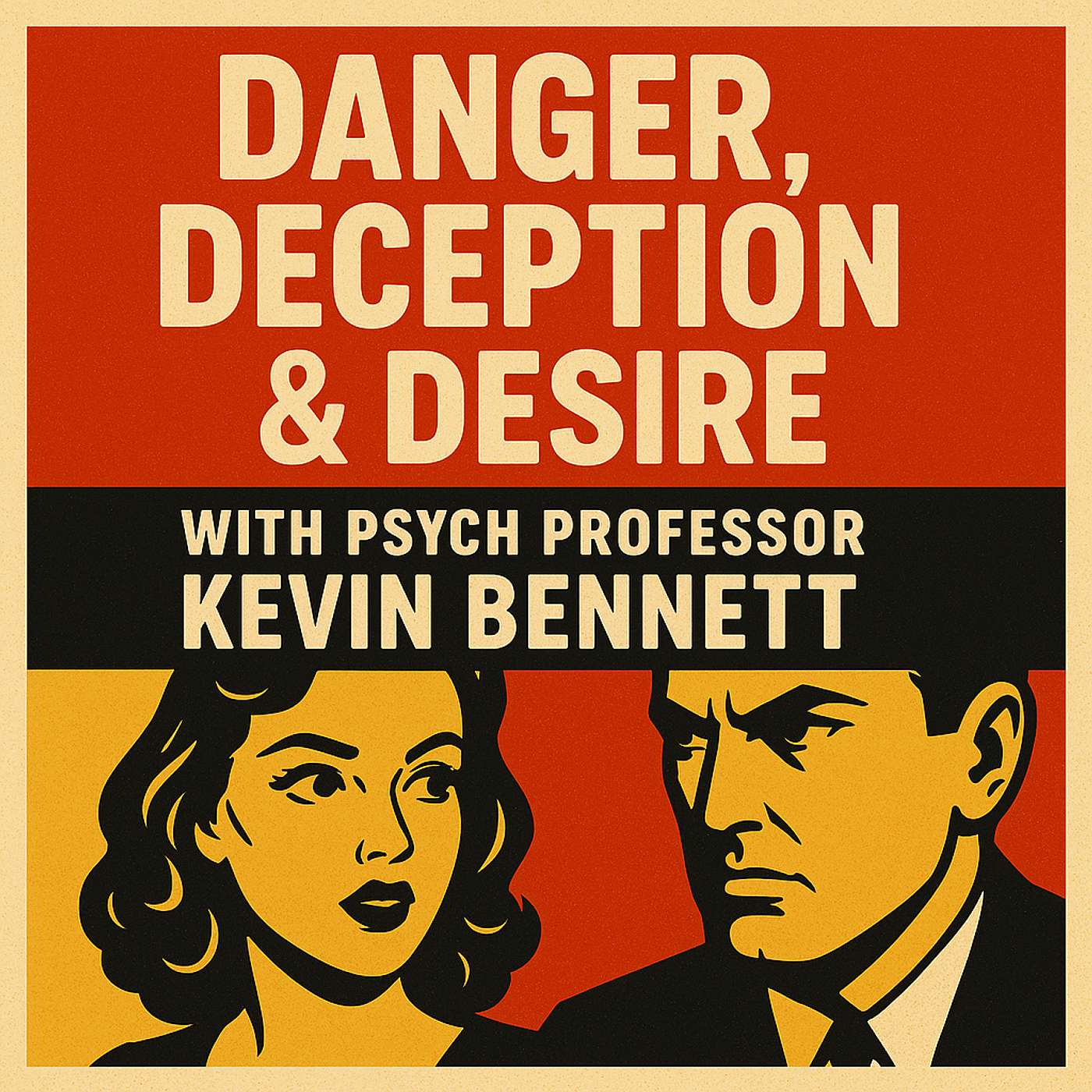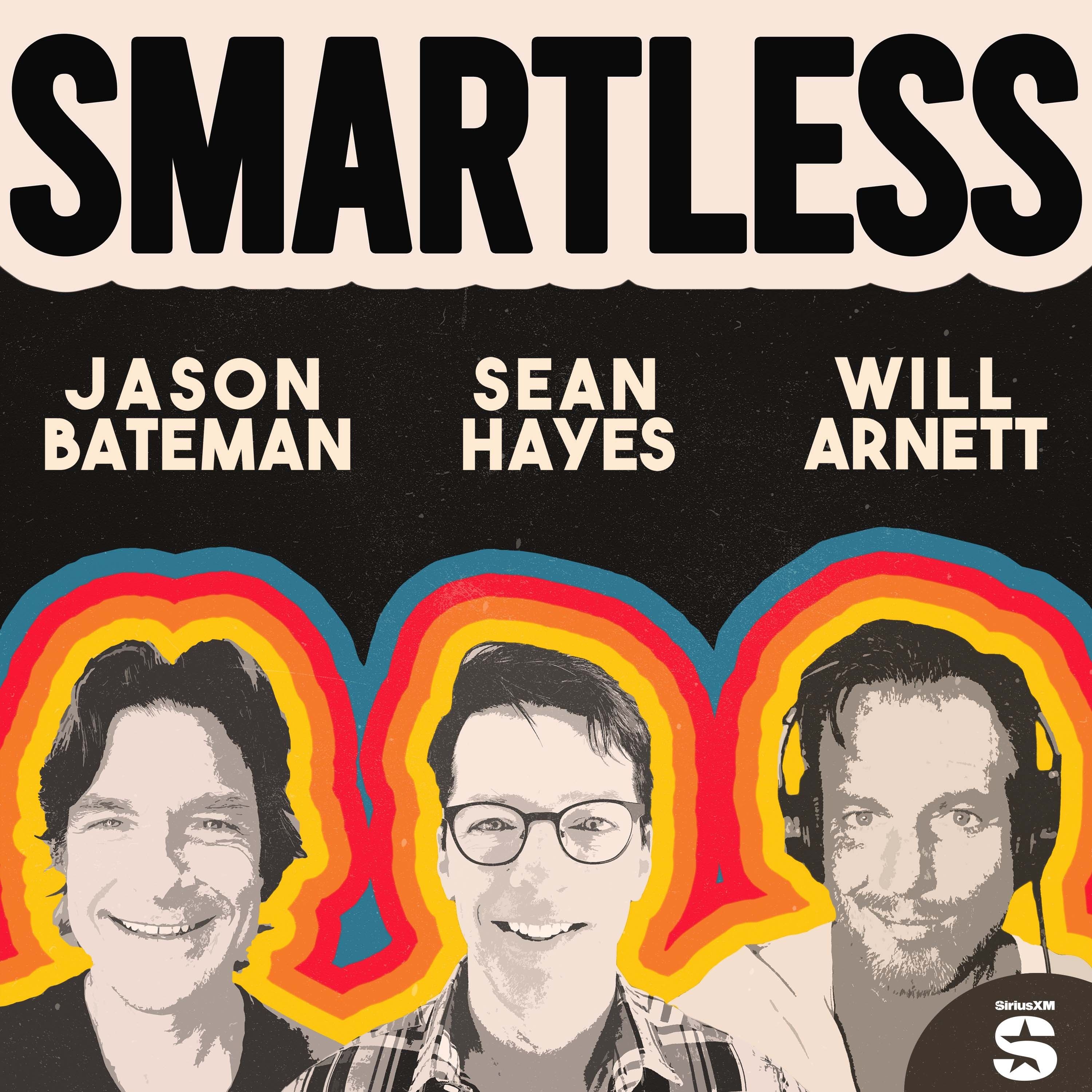
Danger, Deception & Desire
Danger, deception, desire, & other psych professor obsessions. From the ugly truth about rage rooms and our unhealthy obsession with serial killers, to the ancestral wisdom of goosebumps and the science behind why we keep playing the lottery, join Dr. Kevin Bennett—Penn State University Beaver Campus Teaching Professor, Psychology Today contributor, and fellow at the Centre for Urban Design and Mental Health (UD/MH)—as we unmask the power of danger, deception, and desire through sensational stories and savvy behavioral science.
Danger, Deception & Desire
The Night Stalker: How Richard Ramirez Descended into Evil (Part 1 of 2)
Have you ever wondered how early trauma and untreated medical conditions can shape a criminal mind? Join me, Kevin Bennett, and my guest, Nate Coonfare, on this episode as we promise to unravel the chilling life story of Richard Ramirez, a.k.a., The Night Stalker. Together, we explore his tumultuous upbringing in El Paso, Texas, marked by violence and abuse, and how these early experiences set the stage for his terrifying crimes in Los Angeles during the summer of 1985.
Ramirez's descent into violent behavior, catalyzed by witnessing his cousin Mike commit a murder right before his eyes, began at a young age. By examining his exposure to criminal activities and disturbing influences from family members, we offer a comprehensive view of how Ramirez's promising athletic future was derailed by untreated epilepsy and a toxic environment. Nate shares intimate details about Ramirez's transformation from a troubled teenager into a ruthless killer, providing listeners with a deeper understanding of the experiences that shaped his psyche.
Get ready to hear about the harrowing crimes that defined Ramirez's reign of terror. From his initial attack on Maria Hernandez and her roommate to the vicious murders of Maxon and Lela Kneiding , we explore the brutal methods and significant evidence that led to his capture, including the infamous Avia shoe footprint. Our conversation sheds light on the relentless efforts of law enforcement and the fear that gripped Los Angeles during that summer. Tune in for an eye-opening exploration into the dark mind of Richard Ramirez and the indelible impact of his crimes.
This is part one of two.
* * * * * * * * * * * * * * * * * * * * * * * * * * * * * * * * *
A psych professor's podcast about danger, deception, and desire. From the ugly truth about rage rooms and our unhealthy obsession with serial killers, to the ancestral wisdom of goosebumps and the science behind why we keep playing the lottery, join Dr. Kevin Bennett—Penn State University Beaver Campus Teaching Professor, Psychology Today contributor, and fellow at the Centre for Urban Design and Mental Health (UD/MH)—as we unmask the power of danger, deception, and desire through sensational stories and savvy behavioral science.
Podcast Buzzsprout: https://kevinbennettissnarling.buzzsp...
Podcast YouTube: https://www.youtube.com/@KevinBennettisSnarling
Psychology Today Writing: ...
This episode contains adult language and explicit discussion of murder and assault that some listeners may find traumatic. Due to the graphic nature of this killer's crimes, listener discretion is advised. We recommend extreme caution for children under 14.
Speaker 2:You are listening to Kevin Bennett is Snarling.
Speaker 1:How are you?
Speaker 3:doing today? Good Good. I just came from a long weekend at University Park.
Speaker 1:My name is Kevin Bennett and I am a psychology professor at Penn State University Beaver Campus. This is a show about danger, deception and desire. My guest today is Nate Kuhnfair. Nate is a recent graduate of Penn State University, majoring in criminal justice and minoring in psychology here at the Penn State Beaver Campus. Every other semester I teach a course on the psychology of serial killers at Penn State, and Nate was one of my excellent students in the class this semester. I recently sat down with Nate to talk about serial killer Richard Ramirez, known to many as the Night Stalker. This is part one of our two-part conversation. We are diving into the twisted mind and heinous crimes of one of America's most notorious serial killers, richard Ramirez, better known as the Night Stalker.
Speaker 1:Los Angeles, california, summer 1985. A city accustomed to movies that scare audiences with over-the-top Hollywood violence. Nothing could prepare its residents for the terror that was about to unfold. Richard Ramirez prowled the streets in the dead of night, a sinister figure cloaked in darkness. He wasn't a phantom or a boogeyman from a campfire tale. He was all too real and his actions were the stuff of nightmares. Clad in all black, including black gloves, sunglasses and his infamous ACDC baseball cap, he idolized London's Jack the Ripper and wanted to whip up the same kind of fear in Angelino's. During Ramirez's reign of terror, which spanned over a year, he committed a string of brutal murders, sexual assaults and home invasions. No one was safe, not even in their own homes. He struck without warning, leaving behind a trail of death and destruction.
Speaker 1:But who was Richard Ramirez? What led him down his dark path of violence and depravity? Born in El Paso, texas, ramirez's childhood was marked by violence and dysfunction. His early exposure to crime and abuse laid the groundwork for his descent into darkness. But it wasn't until he moved to Los Angeles that he would fully embrace his demonic impulses. The Night Stalker's crimes were as gruesome as they were random. From the wealthy suburbs of Beverly Hills to the poverty-stricken neighborhoods of East LA, no one was safe from his insatiable bloodlust. His victims ranged in age, gender and ethnicity, making it nearly impossible for law enforcement to predict his next move. But despite the fear and chaos he sowed, ramirez's reign of terror would eventually come to an end, thanks to the tireless efforts of law enforcement and the bravery of those who survived his attacks. In 1985, he was captured and brought to justice, but not before he had forever scarred the collective psyche of a city already haunted by its own demons.
Speaker 2:Kevin Bennett is snarling. Begins now.
Speaker 1:We're going to talk about Richard Ramirez, the Night Stalker. Yes, or is it just Night Stalker? Do you know if there's a the there? I believe they call the Night Stalker, yes, or is it just Night Stalker? Do you know if there's a the?
Speaker 3:there, I believe they call him the Night Stalker. So he was born in 1960, on February 29th, in El Paso, and he was the youngest of five children born to Mexican immigrants, mercedes and Julian Ramirez. His father was an alcoholic and would often beat the children and he would go into violent fits of rage, and he also did this to his wife as well. They lived in poverty and they struggled to make ends meet, and it's said that the children were all born from birth defects and they're thinking that it's from the nuclear fallout in New Mexico in the 1950s and when the wind would blow it would bring the radiation and the fallout from New Mexico to El Paso. And it also says that Mercedes, his mother, when she was pregnant with him she was working at a boot factory and was exposed to all sorts of different chemicals that may have affected his birth. It said that they suffered from bone deformities and respiratory complications.
Speaker 3:And at a very young age Richard was subject to many head injuries. He had a dresser fall on him when he was two years old. It knocked him unconscious for 15 minutes and created a laceration in his forehead that he received 30 stitches for, laceration in his forehead that he received 30 stitches for. And then when he was five, he was hit by a playground swing and after the incident he started to have epileptic seizures. He was taken to the hospital after a second seizure in fifth grade and they diagnosed him with temporal lobe epilepsy and that he was suffering from grand mal seizures. But the doctors left him untreated, said that he would eventually grow out of them, but this continued. He had about two dozen of them a month, but then, once he started to get older, he did eventually grow out of them. But I know for some people they put them on medication, so you would have thought that they would have maybe tried to help curb them a little bit, but that's not the case.
Speaker 1:So he had these, these head, pretty serious head injuries at an early age with the dresser. I mean, that just sounds terrible and I know, you know, when my daughter was younger, we had to make sure that the dresser was attached to the wall, because kids will do that, they'll climb up and then it gets too heavy and it topples over and it's terrible. So that happened to him and it was really serious. And then that playground accident with the swing, and then that really kicked off the grand mal seizures which plagued him for the rest of his life. From what I understand, yes, um so, and it went untreated. Essentially, the doctors basically said well, you know, he'll grow out of it, just live with it. Uh, and that's different. I think that would be treated differently today I believe.
Speaker 3:So I have a. I have a personal friend that has epilepsy and he has to take medicine twice a day, every day, and if he stops taking it he'll have a seizure. Yeah, so it completely curbs it for now, but obviously medicine was a little bit different back then. We're a lot more advanced now.
Speaker 1:And before you move on, so that's interesting about the birth, whatever the the radioactivity that's coming over from new mexico. So have there been other cases in el paso that have been documented of, like you know, higher rates of birth defects? Is you know what they they notice at?
Speaker 3:some point. I mean I would imagine, but in this I just found that it specifically affected. That's what they're thinking. So I'm sure that other people around this same time have experienced this, but I didn't really do much research on anybody else, so I'm not sure if you know. I'm sure somewhere someone has suffered from some kind of fallout repercussions. And then so, as he became older, he was a good student in the classroom. All of his teachers said that he was a bright kid and it just seemed like he didn't care. So then this is when he started to become a loner and he would sleep in the graveyard near his house to escape his father's beating. And then in 1972, when Richard was 12, this is when his older cousin, mike, comes into the picture.
Speaker 3:Mike was a combat veteran in Vietnam. He served two tours as a Green Beret and he was a recognized war hero. He had a bunch of medals and everyone in the community, and even his family, commended him and they looked up to him. Richard saw him as a real life superhero is how it claims from Philip Carlos, the Night Stalker book. And he had been to war and he had confirmed kills and he came back alive. So everyone saw him. Everyone praised him. But there was a really sinister side to Mike. He had a stash of Polaroid pictures up on top of his closet in a shoebox and the pictures were obscene. They had Vietnamese women on their knees being forced to perform oral sex on him. He was holding guns to their head. He also had pictures of the same woman with her decapitated head. So he's showing all of these pictures to Richard and Richard's just fascinated and he would also tell him all of these stories about what they did and how they did stuff, and they really aroused Richard and it's said that he would masturbate to the thought of these pictures and stories and would actually prefer them over the adult magazines. And so him and Mike started really hanging out together. They would drive around the town listening to the radio, they would smoke pot and they would just talk about these stories, which just fascinated Richard beyond belief. And then, on top of it all, mike basically taught Richard everything he learned as a Green Beret. He taught him how to kill with precision. He taught him how to move in silence and how to become undetected and how to blend in with the night.
Speaker 3:On May 4th 1973, richard was over at Mike's house and obviously hanging out as per usual, and Mike's wife Jessie came home, which she wasn't very fond of Mike hanging out with Richard. She often complained about him not getting a job. She came home from the grocery store and she started yelling at Mike and he told her to shut up multiple times and she didn't listen. So he reached on top of the fridge and he grabbed his .38 revolver and he shot her point blank in the face. And Mike turned to Richard after this and told him not to tell anyone that he was there and to keep completely silent about it. And so that's what Richard did. He left, didn't tell anyone, and then a couple days later him and his father returned to the
Speaker 3:scene. It was dusty in there, so it still smelled like dried blood. In the novel the Night Stalker by Philip Carlo he wrote that Richard spoke on this and Richard said that the day I went back to that apartment it was like some kind of mystical experience. It was all quiet and still hot in there. You could smell the dried blood. Particles of dust seemed to hover in the air. I looked at the place where Jesse had fallen and died and I got this kind of tingly feeling. It was the strangest
Speaker 3:thing. Then my father told me to look in her pocketbook for this jewelry my cousin wanted, and I dumped Jesse's pocketbook on the bed and looked through her things. It gave me the weirdest feeling. I mean, I knew her and these were her things and she was dead, murdered, gone, and I was touching her things and it made me feel in contact with her. And so this really set with me, because this is his cousin's wife and he's getting these feelings of her and he just watched her be murdered right in front of
Speaker 3:him. So this is the pictures were one thing, and hearing Mike talk about them and how happy Mike was about them and how much he wanted to tell them, you know, could have influence on a young kid to be like oh you know, these are really cool. You know, my cousin, mike the superhero, thinks they're cool. So now I think they're cool, but I think that this is just completely above that, the fact that his cousin he's going through her dead things and he's getting aroused by it. So then, after this, after this murder, this is where his life really started to plummet. He stopped going to school and he just focused his attention on smoking, weed and stealing from people. So then, the summer, right after the murder, he went to visit his older brother, ruben, in Los Angeles. So this is the first time ever that Richard had left El Paso, texas.
Speaker 1:Let me ask a question right here, because it sounds like you're going to transition to California and that relationship he had with Mike his cousin I think is a really important relationship in his development. And in that traumatic episode where he had with Mike his cousin, I think is a really important relationship in his development. Yes, and that traumatic episode where he shoots his wife, that's a traumatic, you know, pivotal moment in Richard Ramirez's life. So he was standing right there, he witnessed the murder and that's horrific enough. But then he went back a day or two later with his dad to help clean things up and that's when he got aroused and he was intrigued by the whole thing, and it was around this time too that he was.
Speaker 1:I just read this recently. He was actually on his middle school football team yes, the quarterback. And then the coach said when the coach learned about his seizures, he said absolutely not, you can't play, I can't deal with you know, if something happens right. And that's really unfortunate, because that was actually a way for him to connect with his dad as well, because his dad liked football. And here's richard playing quarterback, yeah, that's awesome. But then he couldn't do it right.
Speaker 3:So it's like those dreams were kind of ripped away from him because of his medical issue and I just wanted to throw that in there it seems like at this point in his life, with the murder, the pictures and then getting removed from the football team, just made him lose it with reality pretty much that you know he may have been on a good path before. Maybe if he wouldn't have met Mike he wouldn't have or maybe not said met him but not hung out with him and been exposed to this stuff that he wouldn't have been quite the person that he became to be.
Speaker 1:Yeah, and I really wonder about that with Ramirez, because it sounded like in some ways he was a good kid when he was really little three, four, five years of age, had those terrible accidents. That's not good, no-transcript, it wasn't healthy in any way and it just seems to continue.
Speaker 3:Yeah, and it gets worse, yeah. So then he goes to Los Angeles and this is his first time, you know, leaving El Paso and his brother, ruben, is. He's in the life of crime down there, and when Richard moves there, ruben teaches him how to pick locks, to avoid and disarm security systems and break into houses from the outside and return out without being caught. So now you take someone that's a skilled burglar and top it with the skills that Mike has already taught him to be a Green Beret. Basically this gives Richard an insane sense of power, and also it was an easy way for him to make money, which he loved, and not have to go to a regular 9-to-5 job, which he loved, and not have to go to a regular 9-to-5 job.
Speaker 3:So Rubin would often take Richard on all of these burglaries where they would break in, steal the valuables and get out without being caught. He found that he was really really, really good at it. So then, on top of the burglary, he was also introduced to porn. In Los Angeles there's prostitutes everywhere on the street, there's X-rated movie theaters, and Richard sort of had an advantage in that way, because he was 13, but he was 5'9" and he was an older-looking kid, so people really didn't look at him too different. He just kind of fit in and was able to go in and go out as he wanted. So this gave him an extreme rush and the fantasies that he was developing were just accepted. In LA it was normal. So I think that this really made him draw to LA.
Speaker 2:He has a laser pointer in one hand and a double shot of espresso in the other. This can only mean one thing.
Speaker 1:Kevin Bennett is snarling.
Speaker 3:After this summer he returns back to El Paso and he moves in with his sister, ruth, and her husband, roberto. And Roberto was a peeping Tom and a sex addict, so he would constantly demand sex from Ruth, and after they would have sex, this wasn't enough for him, so he would leave. He would go creep around in people's backyards and watch them through the window. So, as easily influenced as Richard was at this age, he started going with Roberto on these escapades and Roberto showed him how to do it. So Richard would sneak into these people's houses, steal all of their stuff, using the skills that he learned from Mike, ruben and Roberto, and this just gave him the sense of power. He felt great while he was doing it and because he was good at it. So also at this same time he was perfecting his hunting skills, using his .22 rifle to kill small game with. He would stalk and kill the critters, gut them and then feed the entrails to his dog. And at the same time he was using a bunch of hallucinogenic drugs, lsd, peyote and mushrooms. And so during this time he started really connecting with Satan, which was another driving factor into the person that he would later become things with what he learned from Mike Ruben Roberto the burglaries, the drugs, the psychedelics. He started to just stray away from society, and this is when he started to really become a loner and that he just started to become worshiping Satan and he would just, you know, kind of get away from everybody else and focus on
Speaker 3:himself. So this next part is where Richard really acts on his fantasies. So he's about 15 years old at this time. He's working at a Holiday Inn and this is where he really uses everything he's learned and made it his own. So he received a master key for the Holiday Inn rooms from a friend that used to work there, which the master key obviously opens every door into the place, which he didn't have access to before. So he would watch these people in their rooms from outside through the peep in the curtain, and when he found that they went to sleep and shut all the lights off outside through the peep in the curtain. And when he found that they went to sleep and shut all the lights off, he would unlock their door, army, crawl through the room, find and steal all of their valuables and leave before anyone even knew he was in there. And so this took the entire hotel by surprise because they couldn't figure out who was doing this and obviously Richard wasn't a suspect because of how young he was and there's more factors to
Speaker 3:it. But now there was a woman in her room by herself Her name was Angela Barrios, I believe and she was in her room and she was wearing lingerie and he was watching her through the window. So he decided to act on his fantasies. So he waited for her to go to bed and when he snuck into her room he jumped on top of her from behind and he gagged her. And Angela complied because she was waiting for her husband to come back and her husband was a large man compared to Richard. So when the husband returned he walked right in on Richard on top of his
Speaker 3:wife. So, as any husband would do if a man was on top of their wife, he beat Richard to a bloody pulp, he gave him two black eyes, he busted his mouth open and then Richard was eventually arrested and taken to the hospital to treat his wounds. Well, when he was sent to court and the family the husband and wife they didn't return to testify against Richard, so he was let go because he was a juvenile, he was still a young man. So they thought, oh, he's just a kid, we'll let him go. But he received no punishment, no treatment, which is crazy to me that they saw what happened there and he received nothing for it. He didn't go to juvie, he didn't receive any kind of therapy or anything like that.
Speaker 1:So then let me. Let me talk about a couple of things here, because there's there's so many, you know, interesting factors at play here, and he's 15 years old at the time that this is happening. When he attacked the hotel guest, I don't know if he knew that the husband was coming back.
Speaker 3:I don't believe so he must not have.
Speaker 1:Yeah, but yeah, he gets beaten badly. And then I guess they decided the guests decided not to either press charges or not show up at whatever hearing they had.
Speaker 3:Yeah, I believe they were. So basically he just fizzled out. I believe they were living, they lived somewhere else and I don't think they returned back to El Paso, I think they just wanted to be done with the episode. Just let it go.
Speaker 1:Yeah, and then, like you said, he's a juvenile, so they basically let him go and it's just remarkable that up until this point, he's got these three male, adult males that are influencing him in these negative ways. You just mentioned them all mike and ruben and roberto I forgot about roberto, yeah, uh, and they all basically showed him how to be a, you know, a psychopathic burglar and steal things and use all these tactics that, um, you know, like military might use. So he was really getting like a graduate level training and how to be an effective burglar. And, oh, and you mentioned, yeah, he, he was hurting animals for a while, killing them, gutting them, and he started using pretty hardcore drugs at around that time.
Speaker 1:So these things are all coming together, all these these really negative variables, okay and so, oh, and the other thing I want to mention is the these satanic impulses that he has, and he was raised in a in a fairly religious family. From what I understand, they were devout Catholics. His mom, especially, would go to church and she would take him and he was a good, you know little church going Richard, and and then at some point he just goes to the other side or feels like he he's not. You know, catholicism is not working for him, so he's got to start worshiping somebody else.
Speaker 3:I think another reason why he was so drawn to Satan is because he felt like he wasn't going to be judged by Satan and that Satan was more of a friend to him and would encourage stuff that he would do rather than consider it a sin and make him repent for it. From my understanding, that's kind of really what drew him to start following Satan rather than Catholicism anymore.
Speaker 1:Yeah, I mean you wonder, you know, know, how does anyone get drawn into that? I I think the the seizures may have played a role also, because he was. He was having almost hallucinations at times as a, I think, a direct or indirect result of the the seizures. So he was seeing visions and I think he sort of interpreted those as being satan to him. And it may have just been hallucinogenic you know nonsense going on in his head, but he made some sense of it and that was, you know, satan is there.
Speaker 3:And I think what most people misconceive about Richard Ramirez is, you know, whenever you read this stuff, if you didn't know his age, you would think that he's a grown man doing this kind of stuff. But the fact that he was so young I mean, at 15 years old, you're still playing on the playground at the park, starting to get a little bit more into more adult stuff, but this is just crazy. No, 15-year-old should even be remotely exposed to any of this.
Speaker 1:No, no, I mean, it's at that age where you're you know you're forming friendships, you're trying to ask people out on dates and, you know, struggle with all those normal things, but here he is, you know, breaking into rooms and attempting to rape people and, yeah, it's no, none of this should be happening to a 15 year old, and then I also saw that when he was working at the hotel there was suspicion of two children being molested in an elevator.
Speaker 3:But they assume that it's Richard, but he was never reported or charged for it. But I just figured that that was something that I would add in here, because what we'll get into later doesn't surprise me from him right.
Speaker 1:I was gonna say my initial instinct was well, is that really part of his mo? But it probably is, because his mo is essentially anyone, anything, anyone. So the fact that he would attack, you know, adults or even elderly people and then attack kids, I mean it's consistent with his character, right? Whereas for other serial killers that might be out of character when you go, this person has never had an interest in children, so maybe it's not them, but for him it's quite possible.
Speaker 3:So then after this, he drops out of high school. He failed ninth grade multiple times and when he turned 18, he moved to California. He moved back to Los Angeles to get away and to completely leave El Paso. He left everything behind, he stopped talking to his family and he just moved away. So he just lived this violent, criminal lifestyle down there.
Speaker 3:He was homeless and poor, so he would turn to theft and burglary to support himself and his extensive drug habit. He was 100% addicted to alcohol and cocaine and he would just go into nice neighborhoods do his same thing. He would break in undetected, steal all the valuables and leave. And this is how he would support himself and leave. And this is how he would support himself.
Speaker 3:And this is where his hygiene started to come into play. He let his hygiene go. It completely withered away. His teeth were completely rotted, they were stained brown, some of them were missing. They were awful and the smell that he let off, that people later on in the people that survived his attacks will later explain his smell, that it was pungent, that he was just someone like you couldn't mistake that for anyone else, that it was the Night Stalker, that it was such a distinct and horrific smell, horrific smell. And so then, at this same time, he was arrested multiple times for breaking and entering theft, and auto theft was a big one the the famous mug shot that if you look up richard ramirez and you see him in his shirts on button, he was actually arrested for auto theft in that picture and in other pictures you could see his.
Speaker 3:His teeth Right, they look terrible, and his mouth like. You could just tell the way that he has his mouth open. It's just, it's disgusting. And so he uses Satan as his guidance and his protector, and then his murder spree begins. So on April 10th on 1984, nine-year-old May Lung was raped and stabbed to death in the basement of a hotel that Ramirez was living in, and he hung her body from a pipe where she was eventually found, and so this murder was not directly linked to his crime spree at first, but they reopened the case in 2004 and the dna from his past crime scenes and him actually matched with this. So this april 10th 1984 murder was not directly linked to his initial crime spree until later on okay, I didn't realize that.
Speaker 1:Yeah, that's interesting because linkage is always an issue with these serial killers. They're trying to figure out which of these crimes are connected.
Speaker 3:So he wasn't initially convicted of this, until they found later on in 2004 that this was actually him that did it. So the first murder to his spree actually occurred on June 28, 1984. Richard entered the home of Jenny Vincow, who was a 79-year-old woman, and he stabbed her to death as she slept. He slashed her throat so deep that he almost decapitated her head, and then he had sex with her corpse. And it just continues down here.
Speaker 3:On March 27th 1985, ramirez attacks Maria Hernandez, who was 22, and her roommate Dale Yoshi Okazaki, who was 34, outside their apartment. Hernandez was leaving her apartment and Ramirez shot her in the face, but she happened to put up a set of car keys which actually deflected the bullet somewhat, which saved her life. But unfortunately, okazaki was fatally shot in the head, and so an hour later after this initial attack, he pulled a woman from her car and brutally beat her on the street and stole her vehicle. And so, after this attack, this is where he adopted the name the Valley Intruder, so this is what they called him initially, as he was breaking into these people's houses and hurting them.
Speaker 3:So then, on March 27th 1985, richard Ramirez entered the home of Vincent Charles Zazara and his wife, maxine Lavinia Zazara, and he had previously burglarized this home, and so he shot and killed Vincent as he was asleep, and when Maxine woke from this gunshot he beat her almost to death, stole all of the valuables. Then he goes back to Maxine, he shoots her three times, stabs her multiple times and gouges her eyes out. He then carved a letter T into her chest, and when he leaves he went out of a window and he left a footprint. But the footprint is a staple in the case because it was one of two Avia shoes. I don't remember what exact model of the shoes, but there was only two sold in the United States and he was one of the owners. So this footprint has matched other footprints from the previous attacks.
Speaker 2:This podcast was recorded and edited by Kevin Bennett in the beautiful foothills of Western Pennsylvania. You can find Kevin on Twitter at KevinBennettPhD. For email, Facebook and other contact info, head over to Kevin-Bennettcom. That's Kevin Bennett, with a dash in between.
Speaker 1:If you are interested in more stories about psychology, science and pop culture with a dash in between.
Podcasts we love
Check out these other fine podcasts recommended by us, not an algorithm.

Serial Killers
Spotify Studios
99% Invisible
Roman Mars
TED Talks
Adswizz
Danger, Deception & Desire
Kevin Bennett
Crime Junkie
Audiochuck.jpg)
A Neuroscientist Explains
The Guardian
Conan O’Brien Needs A Friend
Team Coco & Earwolf
Hidden Brain
Hidden Brain, Shankar Vedantam
SmartLess
Jason Bateman, Sean Hayes, Will Arnett
